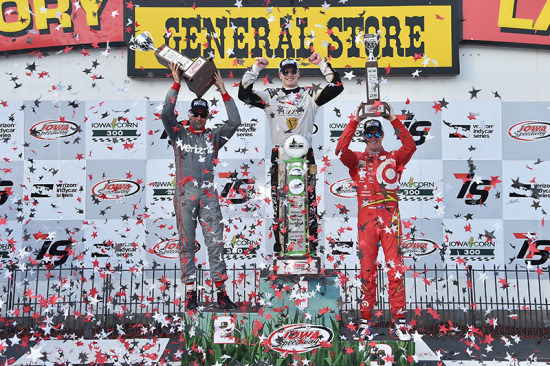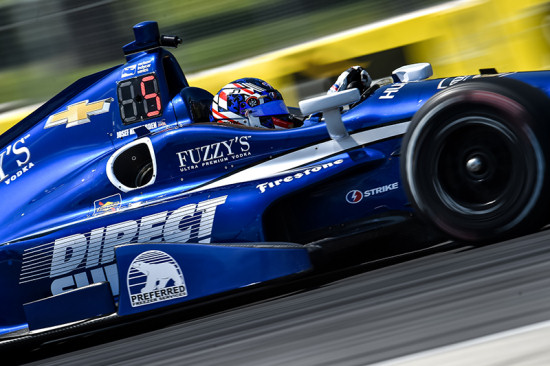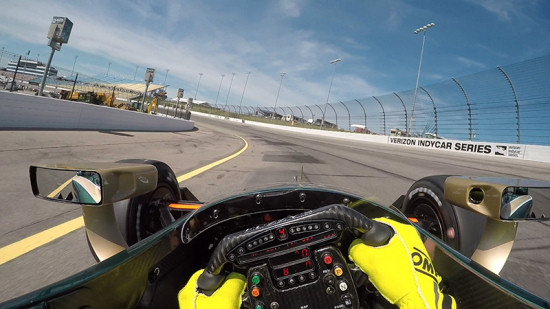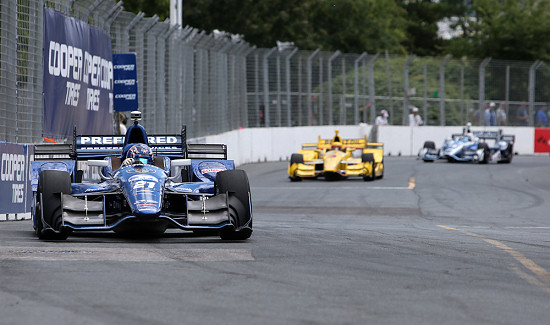The Way It Is/ Josef Newgarden's IndyCar analysisby Gordon Kirby |
 Josef Newgarden has shown us this summer that he's one of the world's fastest and toughest drivers. Newgarden bounced back from a big accident at Texas in June to fight his way to eighth place at Elkhart Lake two weeks later before scoring a dominant victory on the short, banked Iowa oval a month after his accident. It was one of the most dominant performances in IndyCar history and confirmed Newgarden's standing at the pinnacle of the sport.
Josef Newgarden has shown us this summer that he's one of the world's fastest and toughest drivers. Newgarden bounced back from a big accident at Texas in June to fight his way to eighth place at Elkhart Lake two weeks later before scoring a dominant victory on the short, banked Iowa oval a month after his accident. It was one of the most dominant performances in IndyCar history and confirmed Newgarden's standing at the pinnacle of the sport.
Recently, I enjoyed a discussion with Josef about the challenges of racing a modern Indy car and his ideas about the best way forward for the sport. We started by talking about the amount of downforce today's Dallara Indy cars make and how Firestone's tires work on the wide variety of tracks IndyCar races on. Josef first talked about oval tracks. "In race trim on the speedways we're generally running 2,100-2,500 pounds of downforce in race configuration," Newgarden said. "That's what we've been running the last couple of years depending on the amount of mechanical grip. "Firestone has really provided a very consistent tire for us which is good in a lot of respects because it allows you as a driver to push the limits of the car continuously throughout a run, which is fun. It's nice when you have a stable, consistent tire. They do degrade but I think for everyone that's a little different. I think you can actually manipulate the tire to degrade on one end or the other.  © Ed Carpenter Racing "At Indianapolis, we're not really pedaling the car much. With the downforce levels we run you really should be flat out through a whole stint. The only time you're lifting is in severe traffic or enough traffic where you're losing enough downforce that you have to lift and really, there is very little or no tire degradation." Newgarden next addressed the road and street tracks. "On the road courses and street circuits the setups are really quite similar," he said. "Some road courses you have to use a lot more downforce and on some others you're a lot more trimmed out because of the long straights. I would say as an average for all of them we're making between 6,000-7,000 ponds of downforce, which is pretty astronomical. That's a way higher number than anyone has ever produced on an Indy car and more than any Formula 1 car. The grip level from the wings is pretty significant. In fact, it's huge. "The tires are similar to the ovals. Firestone has the softer red and harder black compounds and they are very consistent tires that are very easy to bring in. I don't have any problem with a consistent tire. I think it allows the driver to extract what he needs to extract from it and drive the car to the limit without much drop off. "I like a consistent tire. Some people argue that the more tire degradation you have, the better the racing because people struggle. I don't mind that, but I think if we create cars that are easier to follow like a Formula Ford and the tires last really well throughout the stint, that's not going to change the nature of the racing. We have trouble following each other closely because of the aerodynamic effects on the car and the massive amount of downforce the cars make. If we fixed the aerodynamic problem so we could run closer and we had enough mechanical grip the racing would be great. "There are some tracks where we have high degradation and some tracks where we have low degradation depending on the surface. I would say the Barber and Sonoma road courses are two of the highest degradation circuits that we race on. At Sonoma you'll experience a lot of overall degradation in grip, more at the rear end and that makes it pretty difficult to drive because you fall off pretty aggressively, probably about two and half to three seconds per lap. At Mid-Ohio, that degradation is cut almost in half. It really depends on the surface."  © Ed Carpenter Racing "I think we had a pretty nice formula with the original DW12 Dallara," he said. "It had an absolutely hideous body kit, but it was great for following relatively close in a modern formula car. That was the closest racing we ever had but we've taken some steps back from that over the last couple of years with the aero kits. It hasn't been terrible racing. We've still proved that we can run very close with massive winged cars, but it's not been as strong as it with the original DW12. "With the current car and the aero kits, it's a struggle to follow another guy closely. There has to be some drop off in the tires to allow you to race more closely and pass people. "We took off the downforce with the DW12. It made the car harder to drive but the races on the ovals were terrible. We had terrible races at Texas and everyone complained so we cut the downforce back and we went a little too far. There is a balancing act and we're not going to be able to fix it with our current formula. We have our best racing now when we have a little bit too much downforce but that's the way the formula has been written. "The problem with the current car is you can't just take the wings off. The entire design is made for what the car is today, not what we're suggesting. The floor is all wrong for running a car without wings. You would have to make a whole new car. "But I think Firestone has done a pretty good job with their tires for the current formula. The amount of drop off that we have is probably about what it should be. We have a relative drop off that we have to deal with but it's not so exaggerated so that it looks stupid and we have to start slowing-down too much in lap time. I think it's about right at the moment. "Some tracks separate drivers more than others, but there are times when we reach a certain level of grip at Mid-Ohio for instance. When you get plenty of rubber laid down at Mid-Ohio the grip level is so high that I think the field becomes a little artificially close together. I think the front and the rear of the field should always be close. When you have good teams and good drivers they're always going to be close and pushing each other. But I don't think it's good when the entire field becomes very close and you see people doing things that you don't think they can do."  © Ed Carpenter Racing "You really want to be able to separate yourself by having a little better talent behind the wheel," he remarked. "I think more horsepower would be one of the main things in achieving that and also by providing a car that is mechanically robust and more mechanically dependent to drive. With a bias ply tire you would get that. "If I was to dream up my own formula I think it would be cool if we had bias tires again. For me personally, bias tires are way more fun to drive than radials because you can continually slip the tire with minimal grip loss. With the way the tires work now they have a pretty nice slip angle so you slip the tire to a certain point but when you go over the slip angle it doesn't fall off a cliff as badly as it could. Some tires are not as friendly, but the Firestones are quite friendly for that. "But a bias ply tire would be extremely friendly and I think it would encourage more sliding. I think visually you would see larger slides whereas right now with the current tire people don't really see it when the car is sliding. We're sliding all the time but people can't see it because it's such a micro slide. It doesn't feel small inside the car but it doesn't look very big from the outside. But with a bias ply tire you would see more sliding. I think it would look more spectacular and it would be a lot more fun." Newgarden realizes a move to bias tires would be tough to sell. "I guess that would be a difficult move for Firestone or any tire company to make because it's so important for them that the product they race is relatable to the product they sell," he said. "The engine manufacturers want the engines to be relatable to their production road cars and it's the same thing with tires. So it would be difficult to convince any tire manufacturer to go back to bias tires.  © Ed Carpenter Racing "I think people watch an IndyCar race to watch a spectacle. I don't think they watch a race and then decide to go out and buy a certain product for their car. Yes, they're impressed with the technical development Chevrolet or Honda or Firestone is doing, but they come to watch a spectacle and to see the best drivers in the world wrestle these cars around the track. I think that's what race fans want to see. They want to see the coolest cars on the planet. "I've driven a Formula Ford with radial tires and bias ply tires. It's obviously not the scale of an Indy car but it's the same philosophy. It's very difficult to drive a Formula Ford on radials fast. I'm on the edge, I'm slipping the tires as much as I can get away with. I'm not getting that much angle and it doesn't look that spectacular but inside the car it's just as much work. "But if I go onto a bias ply tire I can slide the car super sideways without losing a bunch of speed and you still have relatively the same grip level as when you weren't sliding as much on the radials. It's still the same level of difficulty but it's more fun and it looks spectacular. So I believe going to bias tires would look a lot more spectacular, would be cooler for the drivers and the fans and would resonate with the fans because they could see more of what we're doing." Newgarden described his own ideal IndyCar formula. "The first thing I would want is huge power," he declared. "I think there's a limit to that too, but I think 1,000 horsepower would be really nice to have. Of course, that has to be properly mated with the car but it would be really nice to have between 900-1,000 horsepower and build that on a robust chassis with huge ground effects. Your primary source of aerodynamic grip should come from the ground effects and the underbody. "For me, you make a spec underbody floor. You make it as bad ass as you can and make it a spec piece so nobody can touch the thing. Then you provide some opportunities to make some low drag efficiencies on the top side of the car and not worry so much about making downforce. People are obviously going to find some ways to make some downforce but the main effort should go into reducing drag.  © Ed Carpenter Racing "I also think what Formula 1 is doing with their tire sizes for 2017 is awesome. On an Indy car I would widen the tires quite a bit and provide a lot of mechanical grip to assist the aerodynamic power from the floor of the car. When you're following someone the aerodynamic power from the bottom of the car is not as destructive as it is with big wings on the top of the car. "So my ideal formula would be 1,000 horsepower, big tunnels, big wide tires and a couple of areas, but nothing major, for people to get inventive on the top side. I think a lot of people, drivers and fans, are in unanimous agreement on that formula. It's a pretty popular formula that many people want to see. It would be massive fun." Newgarden has proven he's a racer's racer as well as a bright, intelligent fellow. It will be interesting and exciting to see what he can do through the final races of the IndyCar season and what 2017 and the future holds for him. And it would be a tremendous thing to see IndyCar adopt Josef's vision of the future. |
|
Auto Racing ~ Gordon Kirby
Copyright ~ All Rights Reserved |
